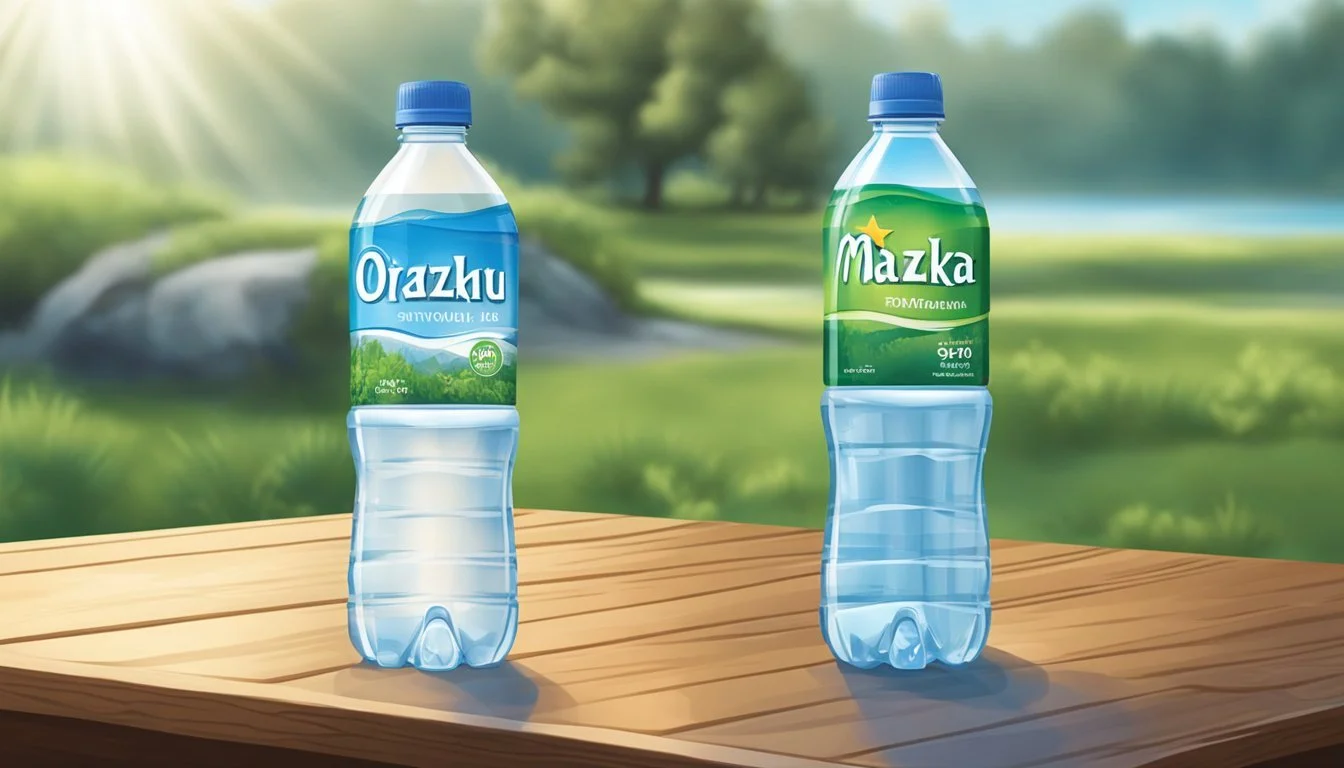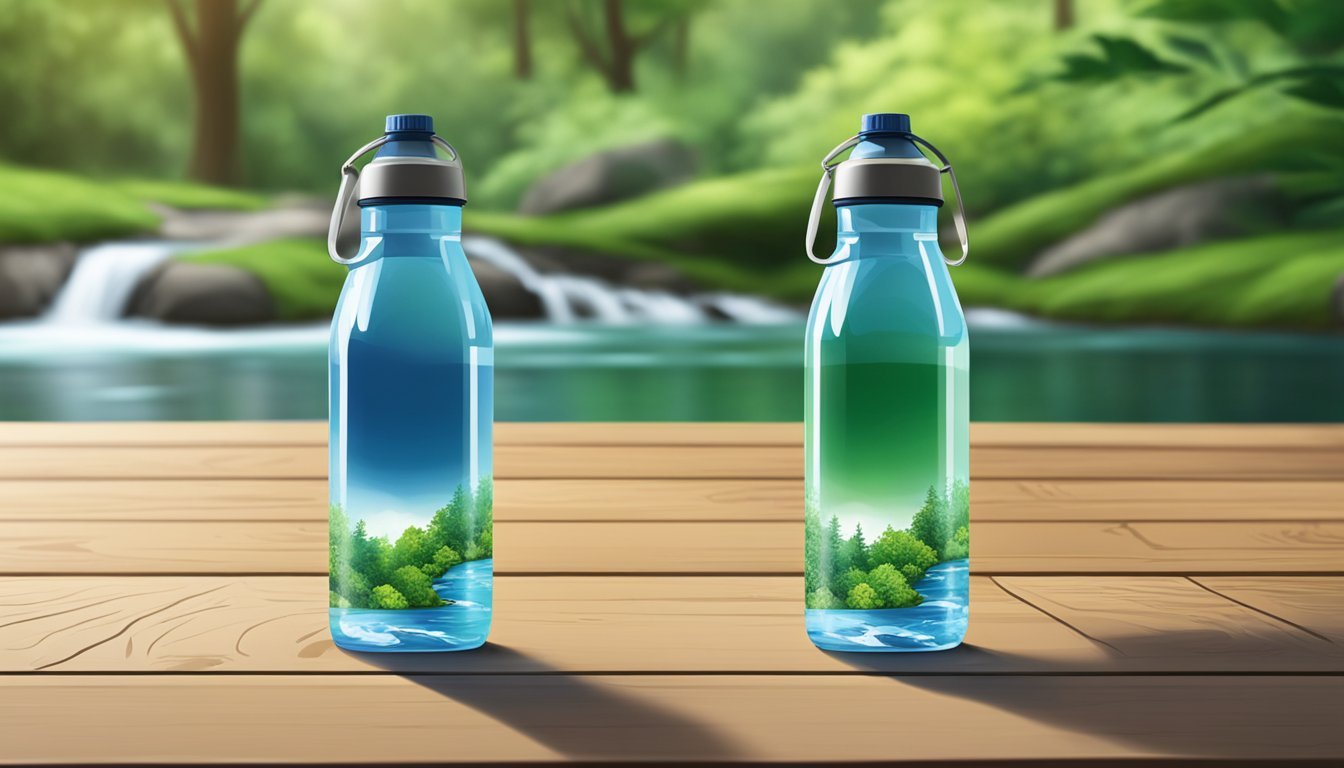Ozarka vs. Mananalu
Comparing Top Bottled Water Brands
Choosing between Ozarka and Mananalu bottled water can be pivotal for discerning consumers. Ozarka, known for sourcing its water locally from Texas, offers a crisp, local taste that many find refreshing. On the other hand, Mananalu, founded by actor Jason Momoa, emphasizes its environmental commitment by using aluminum bottles to promote sustainability.
While both brands prioritize quality, their core differences can appeal to varied preferences and values. Consumers favoring a local product might lean towards Ozarka, recognizing its long-standing presence and regional origins. Conversely, those who prioritize eco-friendly initiatives may find Mananalu's innovative packaging and mission-driven approach more compelling.
By understanding these distinct characteristics, readers can make an informed choice that aligns with their tastes and values. Explore further to see where these brands stand in terms of taste, sourcing, and environmental impact.
Understanding Bottled Water
Choosing the right bottled water involves examining different types, regulatory standards, and environmental impacts. This section explores these key areas to help readers make a more informed decision.
Types of Bottled Water
Bottled water comes in various forms: natural spring water, purified water, mineral water, and alkaline water.
Natural spring water is sourced from underground springs and is often valued for its natural mineral content.
Purified water undergoes processes like reverse osmosis or distillation, removing impurities for a cleaner taste.
Mineral water contains specific minerals like calcium and magnesium, which many believe offer health benefits.
Alkaline water has a higher pH level, which some claim helps neutralize acid in the body.
Different types cater to various preferences and perceived health benefits.
Regulatory Standards and Safety
Bottled water is subject to regulation to ensure safety and quality. In the United States, the FDA (Food and Drug Administration) regulates bottled water, while the EPA (Environmental Protection Agency) oversees tap water.
The FDA enforces standards to ensure bottled water is safe for consumption, including limits on contaminants.
To comply, manufacturers must adhere to strict labeling and testing protocols.
Comparison between FDA and EPA standards is crucial for ensuring consistency in water safety, though FDA regulations are often more stringent.
Understanding these regulations helps consumers trust the safety and quality of their bottled water.
The Environment and Bottled Water
The environmental footprint of bottled water is significant, particularly concerning plastic waste and single-use plastics.
Mananalu's approach involves using 100 percent recyclable aluminum cans, promoting a plastic-free alternative.
Ozarka sources water locally, reducing transportation emissions but still relies heavily on plastic bottles.
The production and disposal of plastic bottles contribute to environmental degradation, encouraging brands to use recycled materials to mitigate impact.
Consumers must consider these factors to support environmentally responsible choices.
Source and Origin
Ozarka and Mananalu bottled waters have distinct sources and origins, which influence their taste and quality. These differences result from their unique groundwater and spring water sources, as well as their diverse filtration and bottling methods.
Natural Springs and Aquifers
Ozarka sources its water from various natural springs and aquifers in Texas. These springs are renowned for their purity and are an essential element of the brand’s identity. Ozarka emphasizes sourcing from local springs, ensuring the water retains natural minerals and taste specific to the region.
Mananalu, on the other hand, obtains its water primarily from mountain springs and deep aquifers. These sources are often located in pristine environments, where water purity is naturally high. Mananalu’s connection to volcanic rock formations adds a unique mineral composition to its water, contributing to its distinct taste and quality.
Filtration and Bottling Processes
Ozarka’s water undergoes a rigorous filtration process that primarily includes reverse osmosis. This method ensures that any impurities are effectively removed while preserving essential minerals. The water is then bottled at the source, maintaining its freshness and quality.
Mananalu emphasizes a more natural approach to filtration. Utilizing layers of volcanic rock and natural sand filtration, the water retains its original mineral content. This method not only preserves the water’s natural characteristics but also ensures a balanced pH.
Both brands are committed to maintaining high standards in their bottling processes to deliver pure and refreshing water to consumers.
Brand Profiles
Ozarka and Mananalu stand out in the bottled water market for their unique sourcing and packaging approach catering to different consumer preferences. Ozarka draws its water from Texas springs while Mananalu focuses on eco-friendly aluminum packaging.
Ozarka: From Texas Springs to You
Ozarka sources its water from natural springs located in Texas. This commitment to local sourcing ensures that its water retains a fresh and pure taste.
The brand has built its reputation on quality and reliability, offering clean and refreshing water. Ozarka's products are typically found in plastic packaging, making them lightweight and convenient for everyday use.
Customers often appreciate Ozarka for its natural taste and reasonably priced offerings, which are widely available across various regions. Ozarka’s strong regional ties and consistent quality make it a favorite among consumers who value local products.
Mananalu: Aluminum Bottled Water with a Mission
Mananalu, created by actor Jason Momoa, aims to eliminate single-use plastic waste by providing water in 100 percent recyclable aluminum cans. This eco-friendly approach appeals to environmentally conscious consumers.
Mananalu focuses on sustainability without compromising on water quality. The brand offers purified water that is both clean and environmentally responsible.
The use of aluminum not only protects the water from light and contamination but also supports endless recycling. Mananalu stands out in the market for its innovative design and strong environmental mission, demonstrating a commitment to reducing plastic pollution and promoting sustainable living.
Health and Hydration
Choosing between Ozarka and Mananalu bottled water involves considering their effects on health and hydration. This section explores essential minerals, the role of pH levels, and the comparison of plain water versus enhanced beverages.
Essential Minerals and Your Health
Both Ozarka and Mananalu contain essential minerals that can benefit health. Ozarka sources its water in Texas, providing a natural balance of minerals such as calcium and magnesium. These minerals are crucial for maintaining bone health and metabolic functions.
Mananalu, created by Jason Momoa, focuses on sustainability and health. Its water is purified and often enhanced with electrolytes, which aid in maintaining proper fluid balance and muscle function. The presence of electrolytes can be particularly beneficial for athletes or individuals with high physical activity levels.
Ozarka’s naturally sourced minerals and Mananalu’s additional electrolytes make both options viable for promoting health, although the specific needs of the consumer may favor one over the other.
The Role of pH Levels in Drinking Water
The pH level of water indicates its acidity or alkalinity, which can influence health. Ozarka water generally has a neutral pH that naturally aligns with the body's preference. This ensures that it is neither too acidic nor overly alkaline, providing a balanced option for everyday hydration.
Mananalu often markets its water with a focus on purity and may sometimes offer alkaline water variants. Alkaline water, with a higher pH, is believed by some to provide additional health benefits like reducing acid reflux and improving hydration efficiency. However, scientific evidence on these claims remains inconclusive.
Consumers looking for a neutral pH might prefer Ozarka, whereas those interested in the potential benefits of alkaline water might opt for Mananalu.
Hydration: Water vs. Enhanced Beverages
Hydration is vital for overall health, and both Ozarka and Mananalu excel in this regard. Plain water like Ozarka's is a reliable and effective means to stay hydrated without any added substances. This makes it ideal for daily consumption and maintaining a healthy lifestyle.
Mananalu, on the other hand, sometimes offers water enhanced with electrolytes. Enhanced beverages can be beneficial, particularly after intense exercise, where replenishing electrolytes lost through sweat is crucial. These added nutrients can support faster recovery and better hydration effectiveness post-activity.
For pure, straightforward hydration, Ozarka is a solid choice. Mananalu’s enhanced options provide an edge for those seeking specific functional benefits.
Taste and Purity
To determine the better bottled water between Ozarka and Mananalu, it's essential to examine both taste and purity. Key factors include mineral content and potential contaminants.
The Factors Affecting Water Taste
Taste can significantly vary due to mineral content. Ozarka, being natural spring water, contains minerals like calcium and magnesium, giving it a distinct taste. Customers often favor its slightly earthy flavor.
Mananalu, which is purified water, might have a more neutral taste. The purification process removes impurities but also strips away natural minerals. Sometimes, minerals are reintroduced, yet the taste remains clean and simple.
Taste preferences can be subjective. Some prefer the richness of minerals in Ozarka, while others might favor Mananalu's lighter flavor profile.
Purity and Contaminants
When discussing purity, Ozarka's natural spring water undergoes minimal treatment, retaining its natural mineral content. It's generally free from synthetic contaminants, though natural trace elements might be present.
Mananalu’s purification process removes potential contaminants, such as lead and arsenic. This ensures high purity, but also means the final product is devoid of most natural minerals.
Contaminants like heavy metals are serious concerns. While both brands strive to meet safety standards, Mananalu’s rigorous filtration methods provide an extra layer of assurance against pollutants like sodium, lead, and arsenic.
Sustainability and Impact
When comparing Ozarka and Mananalu, there are significant differences in their approaches to sustainability and environmental impact, especially in their choice of packaging and eco-friendly practices.
Bottles and Eco-Friendly Practices
Ozarka utilizes plastic bottles for packaging. Although plastic is convenient and lightweight, it poses serious environmental challenges. Proper disposal and recycling are crucial to mitigate its impact. Without adequate recycling measures, plastic bottles can contribute significantly to environmental pollution.
Mananalu, founded by Jason Momoa, takes a different approach. The brand uses aluminum bottles for its water, a choice driven by sustainability efforts. Aluminum is more recyclable than plastic, reducing overall waste. Through the “Drink One, Remove One” initiative, for every bottle sold, Mananalu removes an equivalent amount of plastic from the environment, significantly reducing oceanic pollution.
Water Sourcing and Environmental Impact
Ozarka sources its water from natural springs in Texas, emphasizing the purity and local aspect of its product. They must, however, balance their sourcing practices with environmental responsibility to ensure that natural water sources remain viable and are not overexploited.
Mananalu, by contrast, partners with organizations like rePurpose Global to improve its environmental impact beyond just packaging. By engaging in plastic removal from waterways in locations such as Indonesia and Colombia, the company contributes to global sustainability efforts. Their practices not only focus on minimizing resource use but also actively reduce the plastic waste burden on oceans.
Both companies aim to provide clean and safe drinking water, but their methods highlight distinct commitments and strategies to promote environmental sustainability.
Comparative Analysis
The primary focus is on taste, environmental ethics, and cost-effectiveness. Key factors such as mineral content, sustainability practices, and pricing are essential to understand the strengths and weaknesses of Ozarka and Mananalu bottled waters.
Ozarka vs. Mananalu: Taste Test
Ozarka water has a balanced taste profile, primarily due to its mineral content sourced from Texas. The water retains a crisp and clean taste with a slightly mineral-rich finish that appeals to a wide range of consumers.
Mananalu, sourced from pristine locations, offers a distinctively smooth and refreshing flavor. Its taste profile is often described as slightly more neutral and soft compared to Ozarka. This difference makes it suitable for those preferring a less mineralized flavor.
Environmental Ethics: Brand Comparison
Ozarka:
Uses plastic bottles which contribute to environmental pollution.
Has initiated some recycling efforts but remains reliant on single-use plastics.
Mananalu:
Prioritizes sustainability with aluminum packaging that is infinitely recyclable.
Mananalu's commitment to reducing plastic waste makes it an environmentally friendly alternative.
Actively promotes ocean conservation by removing plastic from waterways.
Cost and Accessibility
Ozarka is widely accessible in grocery stores across the United States, particularly in Texas and surrounding regions. It’s often priced competitively, making it a convenient choice for everyday hydration at a reasonable cost.
Mananalu, while slightly more expensive due to its sustainable packaging, offers a premium option for those prioritizing environmental impact. Accessibility might be limited compared to Ozarka but can be found in health stores and specialty retailers, as well as online.
Both brands provide hydration solutions catering to different needs regarding taste preferences, environmental concerns, and budget.
Conclusion
When comparing Ozarka and Mananalu, several factors need to be considered.
Hydration is a priority for both brands, ensuring that they meet consumers' needs efficiently. Ozarka sources its water locally from Texas, offering a reliable hydration source.
Mananalu focuses on sustainability, providing water in 100% recyclable aluminum cans. This reduces plastic waste significantly.
Taste varies greatly between the two. Ozarka's water is known for its crisp, clean taste, while Mananalu maintains a neutral taste that doesn't have a plastic aftertaste.
When it comes to purity, both brands perform well. Ozarka's local sourcing ensures a high level of natural purity. Mananalu, on the other hand, offers purified water, eliminating contaminants.
Convenience is another factor. Ozarka is widely available in bottled form, easy to purchase in many regions. Mananalu's aluminum cans are also convenient and fit the eco-friendly niche.
Health impact considerations include the potential leaching of harmful chemicals from plastic bottles in Ozarka's case. Mananalu's use of aluminum avoids this issue, providing a safer option for long-term consumption.
Comparison Factors Ozarka Mananalu Hydration Reliable source, local Texas water Purified, neutral taste Sustainability Traditional plastic bottles 100% recyclable aluminum cans Taste Crisp, clean Neutral, no plastic aftertaste Purity Natural purity Purified for contaminant removal Convenience Widely available in bottle form Environmentally friendly option Health Potential plastic chemical leaching Safe, no chemicals from packaging
Each brand has its strengths and caters to different consumer preferences and values.
More About Ozarka
Mountain Valley Spring Water vs Ozarka: Which Bottled Water is Better?
Ozarka vs Kirkland Signature: Which Bottled Water is Better?
Ozarka vs Richard's Rainwater: Which Bottled Water is Better?
Ozarka vs Whole Foods Italian Still Mineral water: Which Bottled Water is Better?
More About Mananalu
Hawaiian Springs vs Mananalu: Which Bottled Water is Better?
Icelandic Glacial vs Mananalu: Which Bottled Water is Better?
Mananalu vs Cascade Mountain: Which Bottled Water is Better?
Mananalu vs Kirkland Signature: Which Bottled Water is Better?
Mananalu vs Richard's Rainwater: Which Bottled Water is Better?
Mananalu vs Talking Rain AQA: Which Bottled Water is Better?
Mananalu vs Whole Foods Italian Still Mineral water: Which Bottled Water is Better?
Mountain Valley Spring Water vs Mananalu: Which Bottled Water is Better?
Nestle Pure Life vs Mananalu: Which Bottled Water is Better?







